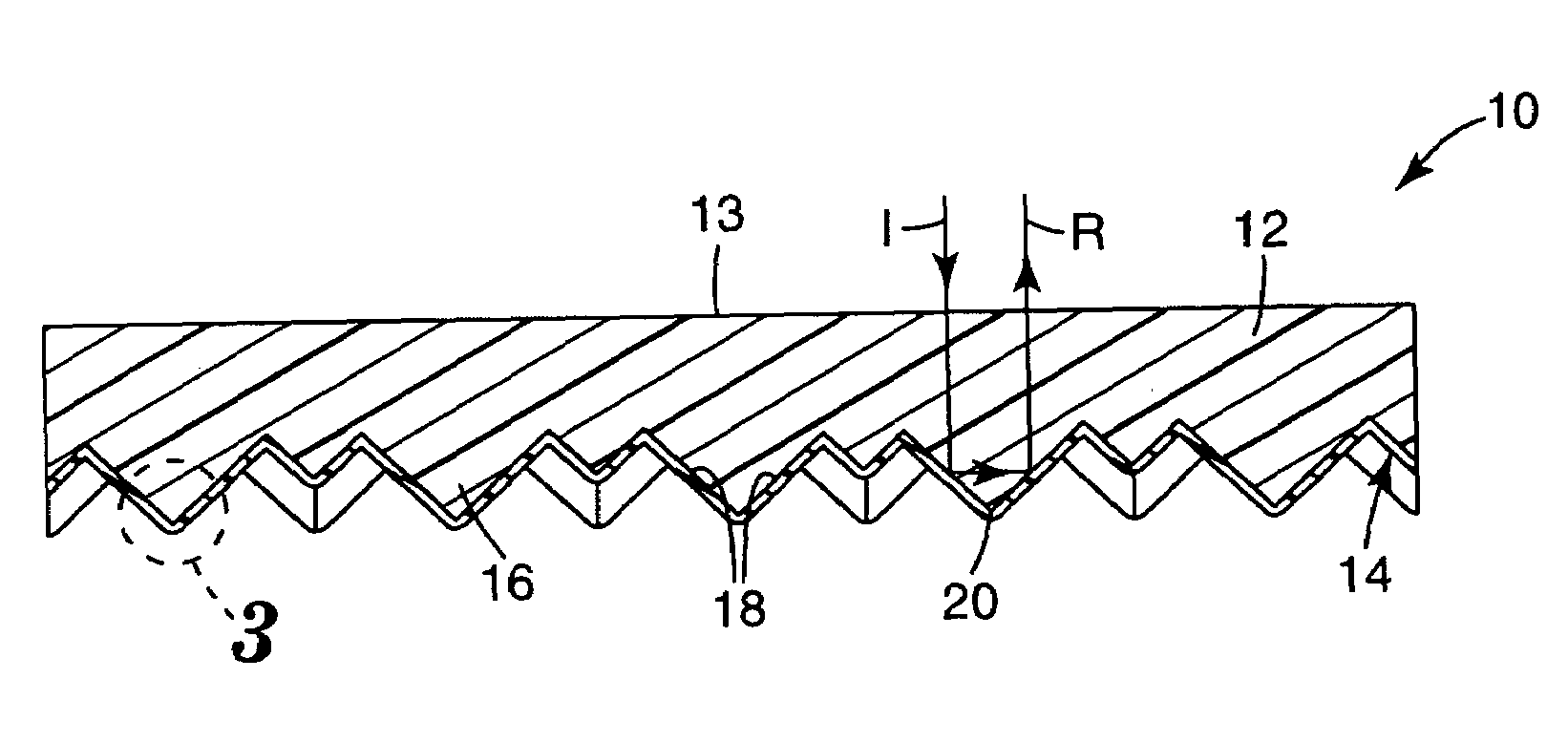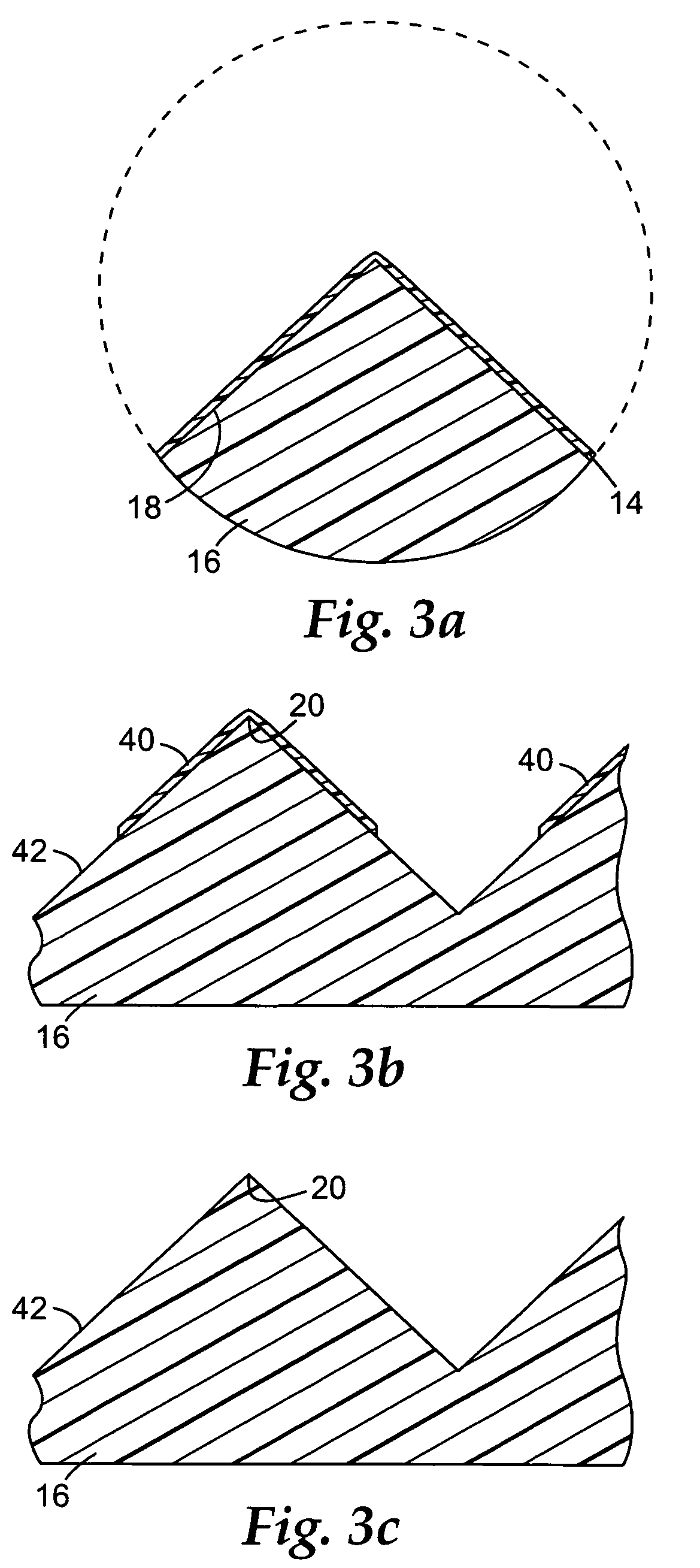Prismatic retroreflective article and method
a retroreflective article and article technology, applied in the field ofprismatic retroreflective articles, can solve the problems of reducing the number of cube-corner elements available for retroreflection, increasing and retroreflective articles can lose most or all of their retroreflection, so as to maintain retroreflection, reduce the number of cube-corners, and increase the weight and cost of articles 150
- Summary
- Abstract
- Description
- Claims
- Application Information
AI Technical Summary
Benefits of technology
Problems solved by technology
Method used
Image
Examples
example 1
[0040]Samples of unsealed cube-corner retroreflective sheeting (having a body layer made from a 0.05 mm thick polyethylene terephthalate glossy top film heat laminated to a 0.11 mm thick polyvinyl chloride film and against which were formed 0.09 mm high UV-cured acrylic cube-corner elements) were plasma-treated in an apparatus like that shown in FIG. 5 using the various treatment conditions shown below in Table I:
[0041]
TABLE IFlowPlasmaLineRunRate,Pressure,Power,Speed,No.Treatment Materialscm3mTorrWm / min.1-1Perfluoropropane60030025001.51-2Perfluoropropane600300250061-3Tetramethylsilane44450–1002001.51-4Tetramethylsilane44450–1002006
[0042]The treated samples were placed flat on a horizontal surface with the cube-corner optical elements facing up. A series of isopropyl alcohol / water mixtures containing 0 to 100 percent isopropyl alcohol and 100 to 0 percent water in 10 percent increments was applied to the treated samples and to a similarly positioned untreated sample. None of the alc...
example 2
[0045]Samples of unsealed cube-corner retroreflective sheeting (having a body layer made from a 0.19 mm thick plasticized polyvinyl chloride film against which were formed 0.09 mm high UV-cured cube-corner elements similar to those employed in Example 2, Composition C-2 of U.S. Pat. No. 5,691,846, but using hexanediol diacrylate in place of tetrahydrofurfuryl acrylate) were plasma-treated in an apparatus like that shown in FIG. 5 using the various treatment conditions shown below in Table II.
[0046]
TABLE IIFlowPlasmaLineRate,Pressure,Power,Speed,Run No.Treatment Materialscm3mTorrWm / min.2-1Perfluoropropane600500225032-2 (1st pass)Oxygen1500150125012.22-2 (2nd pass)Perfluoropropane600150250012.22-3Tetramethylsilane / Oxygen444 / 2507540006.12-4 (1st pass)Oxygen1500150400012.22-4 (2nd pass)Tetramethylsilane / Oxygen444 / 2507540006.1
[0047]The cube side of the Run 2-1 and 2-2 samples was exposed to water, mineral oil, kerosene, mineral spirits and isopropanol. None of the applied liquids wet out...
PUM
 Login to View More
Login to View More Abstract
Description
Claims
Application Information
 Login to View More
Login to View More - R&D
- Intellectual Property
- Life Sciences
- Materials
- Tech Scout
- Unparalleled Data Quality
- Higher Quality Content
- 60% Fewer Hallucinations
Browse by: Latest US Patents, China's latest patents, Technical Efficacy Thesaurus, Application Domain, Technology Topic, Popular Technical Reports.
© 2025 PatSnap. All rights reserved.Legal|Privacy policy|Modern Slavery Act Transparency Statement|Sitemap|About US| Contact US: help@patsnap.com



